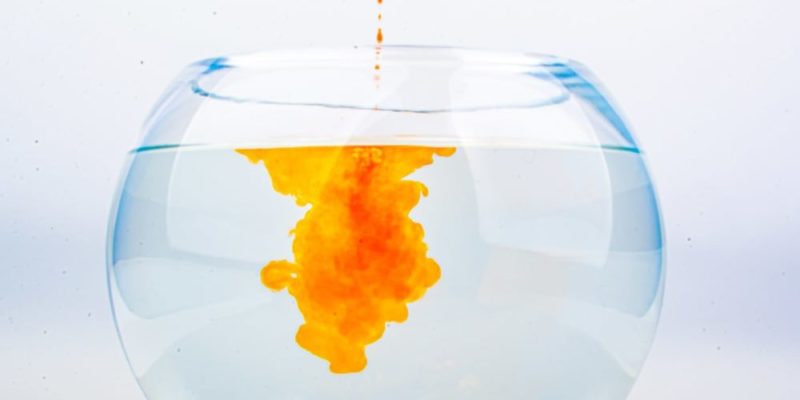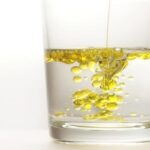We explain what solutions are and how they are classified, their properties and some examples. Difference between solution and dissolution.

What is a dissolution?
A solution is a homogeneous mixture formed by two or more pure substances that do not react chemically with each other. One of these substances is the solvent and the other (or others) is the solute. The distinction between solute and solvent is somewhat arbitrary, but generally the solute is taken to be the component that is in the least amount and the solvent is the component that is in the greatest amount in the solution.
When a solution is formed, the solute (minority) becomes part of the solvent (majority) in the solution thus modifying the physical properties of each pure component separately, such as the boiling or freezing point, but without altering the chemical properties of each one.
The result obtained, in fact, depends largely on the concentration of solute and especially on its solubility coefficient (necessary amount of a substance to saturate a certain amount of solvent) in the solvent (some substances dissolve better in others).
Solutions are classified according to the state of aggregation of their components, into:
- When the solute and solvent are solids. Solutions of solid in solid. Alloys are an example of this type of dissolution. For example: bronze is an alloy of copper (Cu) and tin (Sn).
- When the solute is a solid and the solvent is a liquid Solutions of solid in liquid. They are probably the most used in all branches of chemistry and other fields. For example: a solution of water with salt.
- When the solute is a solid and the solvent is a gas Solutions of solid in gas. For example: dust dissolved in the air.
- When the solute is a liquid and the solvent is a solid. Liquid solutions in solid. For example: amalgams are a solution of liquid mercury and solid silver, or mercury and other metals.
- When the solute is a liquid and the solvent is a liquid. Liquid-in-liquid solutions. They are also widely used in all areas of chemistry, medicine and industry in general. For example, a solution of ethanol in water.
- When the solute is a liquid and the solvent is a gas. Liquid solutions in gas. For example: air or some other humid gas.
- When the solute is a gas and the solvent is a solid Dissolution of a gas in a solid. For example: dissolution of hydrogen in some metals.
- When the solute is a gas and the solvent is a liquid. Dissolution of a gas in liquid. For example: oxygen dissolved in water, which allows fish to breathe.
- When the solute is a gas and the solvent is a gas Dissolution of a gas into a gas. For example: natural gas is a gaseous solution of methane, ethane, propane, butane, carbon dioxide and other gases in small proportions.
See also: Chemical solution
Dissolution and solution
For all practical purposes, The terms dissolution and solution are synonyms. Both refer to homogeneous mixtures, although the term solution often tends to be used more for mixtures in which the solvent is a liquid, and the solute can be liquid, solid or gaseous.
The term solution, on the other hand, is mostly used when both the solvent and the solute are liquids. Likewise, in chemistry both terms are used interchangeably.
Components of a solution

Solutions have two different components:
- Solvent The solvent is the substance in which the solute dissolves, generally it is the most predominant. It is also known as a solvent, dispersant or dispersion medium.
- Solute(s) In this case we are talking about the substance that is dissolved by the solvent. The same solution can have more than one solute dissolved in the same solvent. The solute is present in a smaller quantity than the solvent.
Properties of a solution
The components of a solution cannot be recognized with the naked eye. They also cannot be separated by centrifugation or filtration, but rather by fractional phase separation methods, such as evaporation, distillation or crystallization.
This is because it is a homogeneous mixture, in which no chemical reactions occur, but a result that is different in appearance and physical properties from its predecessor substances is obtained.
Its physical behavior is different from that of its separate components but, on the contrary, they leave the chemical properties of each one unchanged.
As in other mixtures, we can also obtain various types of solutions (and with them, different behaviors) through the final concentration of the solute in the solvent, thus being able to speak of:
- Diluted solutions. Little solute in the same amount of solvent.
- Concentrated solutions Abundant solute in the same amount of solvent.
- Saturated solutions They achieve equilibrium between solute and solvent, without being able to add more solute, at least under certain given conditions of temperature and pressure.
- Supersaturated solutions They are solutions that contain more solute than the saturated solution would have at a certain temperature and pressure. If the temperature of a saturated solution is increased, it is possible to add more solute, but if it is allowed to cool slowly, it can become a supersaturated solution.
Examples of solutions

Examples of solutions are:
- Sugar dissolved in water.
- Salt dissolved in water.
- Sand dissolved in water.
- Alcohol dissolved in water.
- Vinegar dissolved in water.
- Carbon dioxide dissolved in water.
- Sulfur dioxide dissolved in water.
- Hydrogen dissolved in platinum.
- Gold dissolved in mercury.
- Carbon dissolved in iron (steel).
- Zinc dissolved in tin.
- Water vapor dissolved in the air.
- Sublimated iodine dissolved in nitrogen.
Continue with: Heterogeneous mixture
References
- “Dissolution” on Wikipedia.
- “What is a solution?” at TP Chemical Laboratory.
- “Types of solutions depending on the size of the solute” at the University of the Basque Country.
- “What is a dissolution” (video) in Breaking Vlad.
- “Dissolutions” in ICT Resources of the Spanish Ministry of Education.





